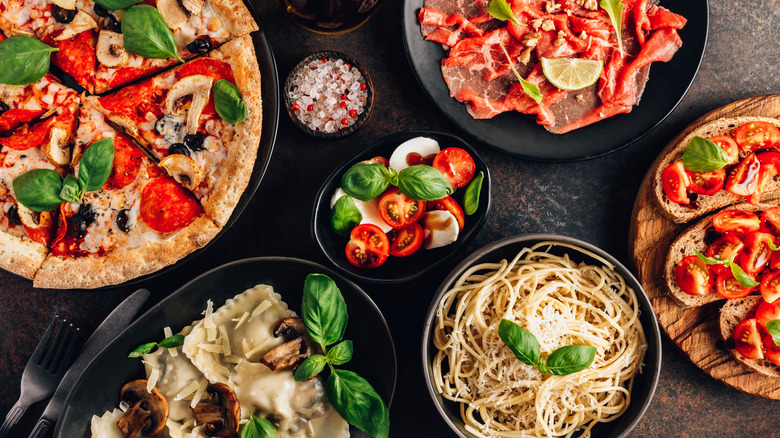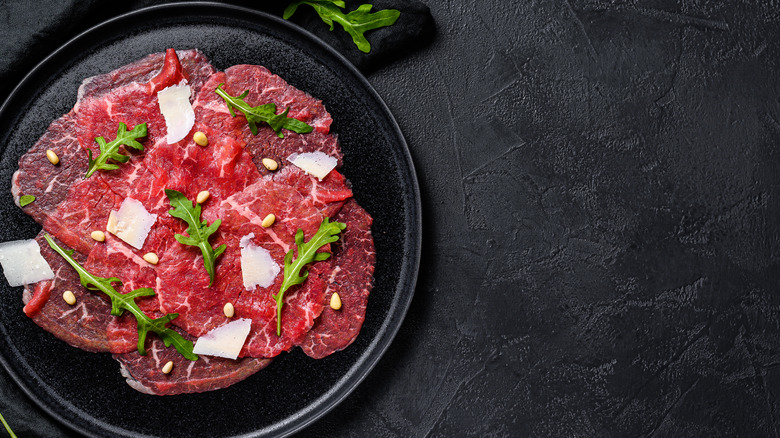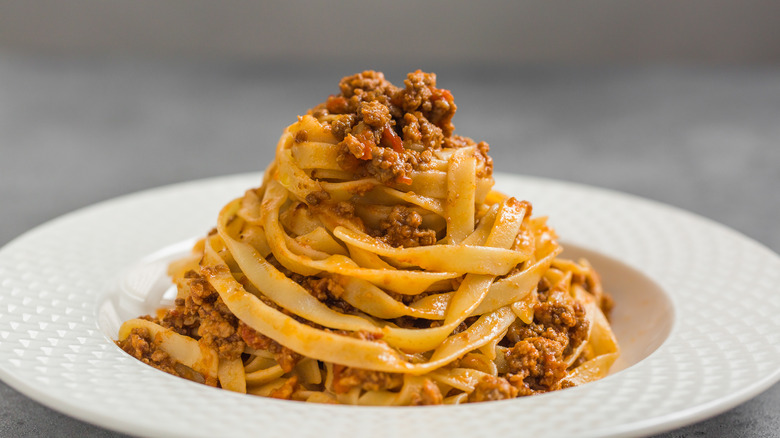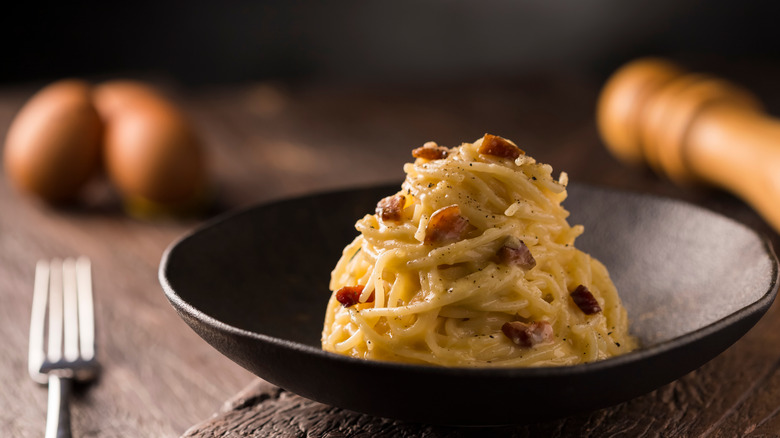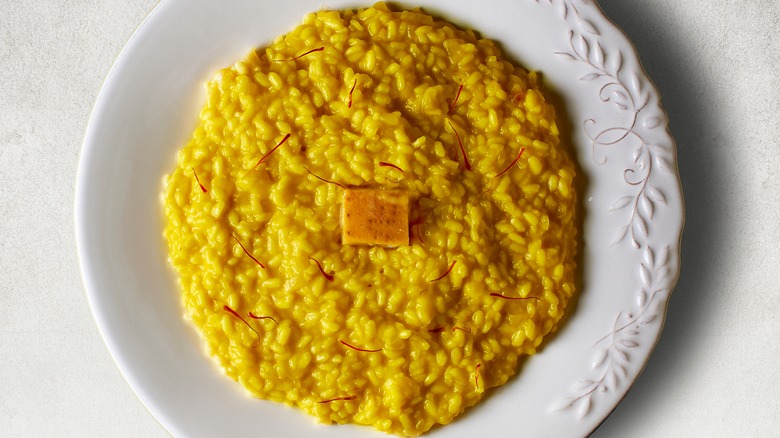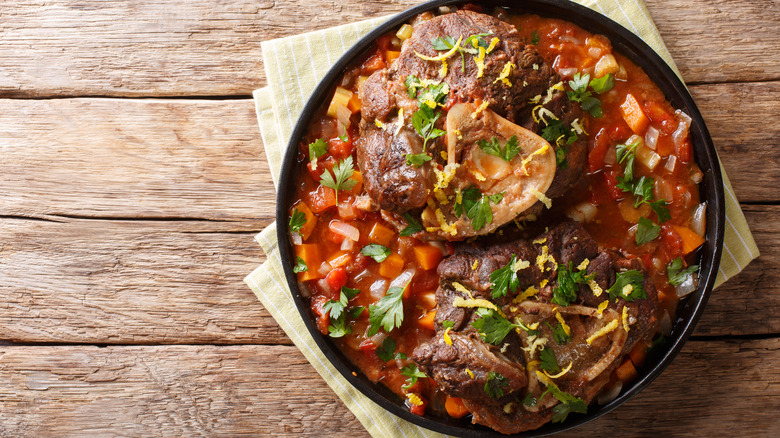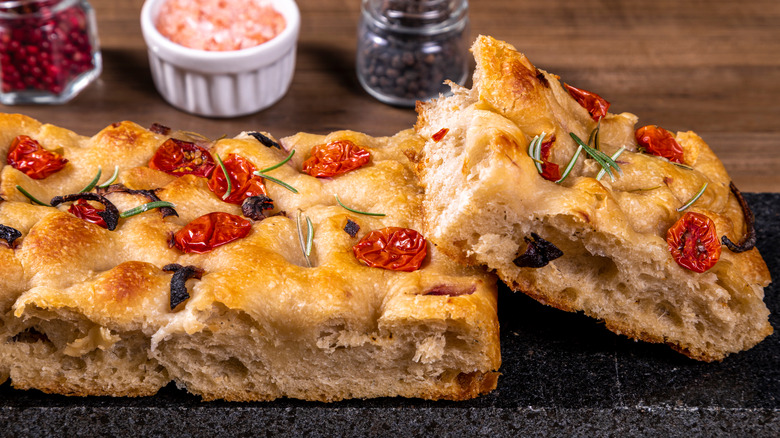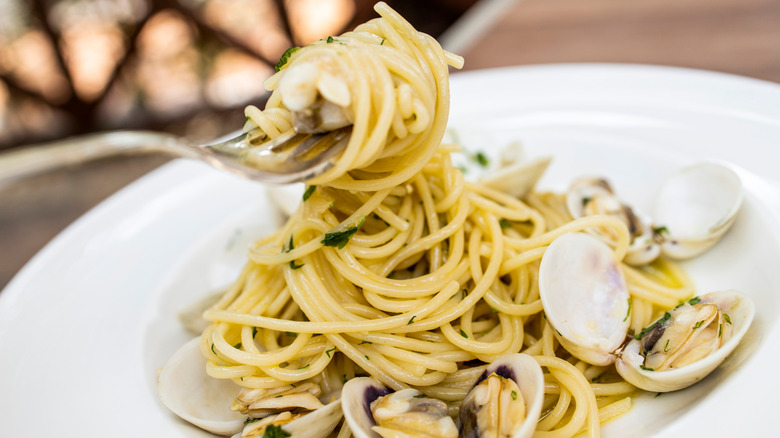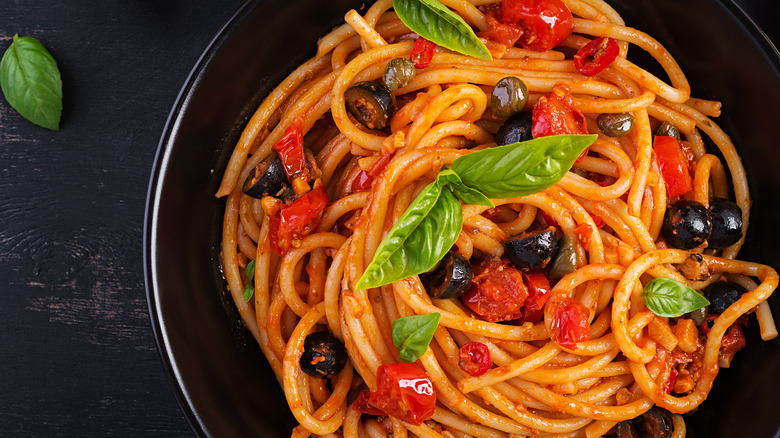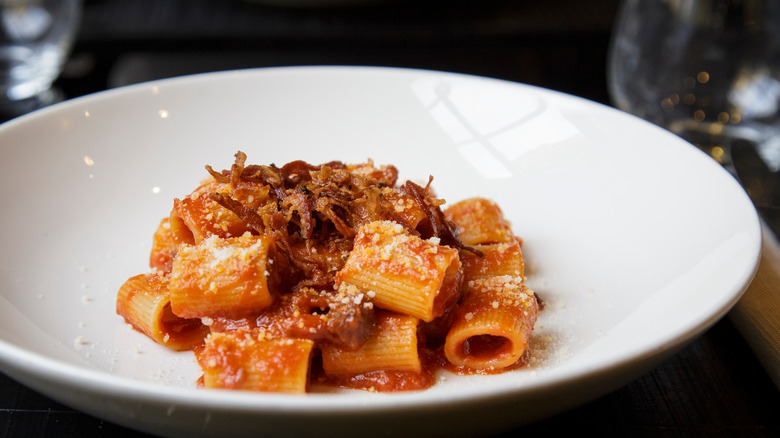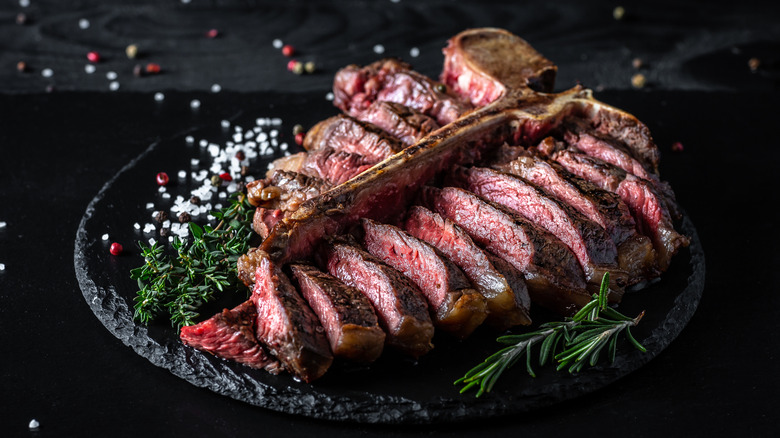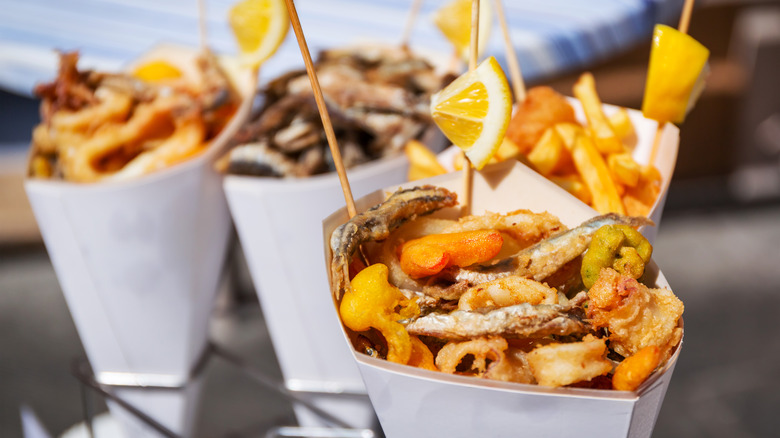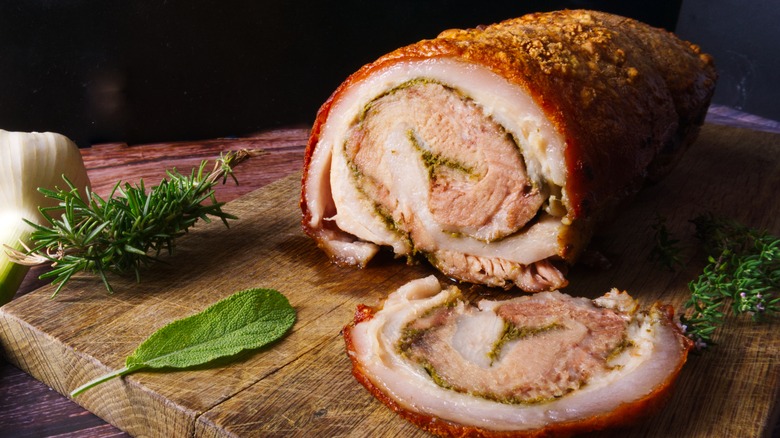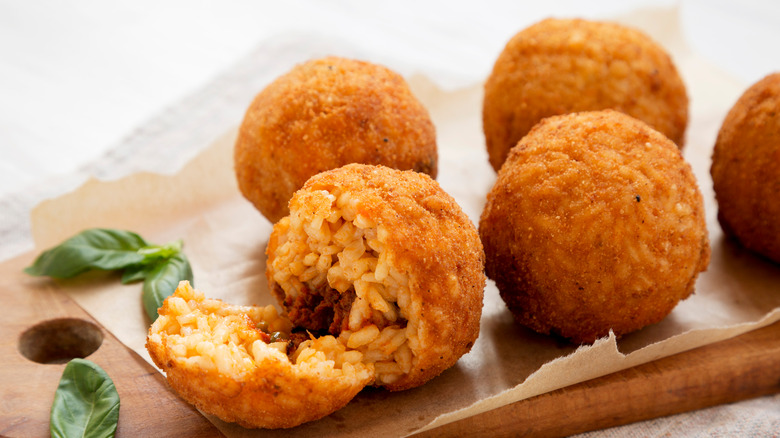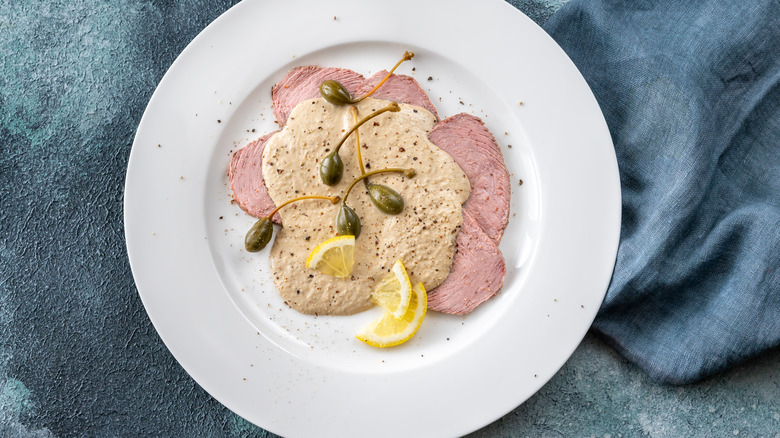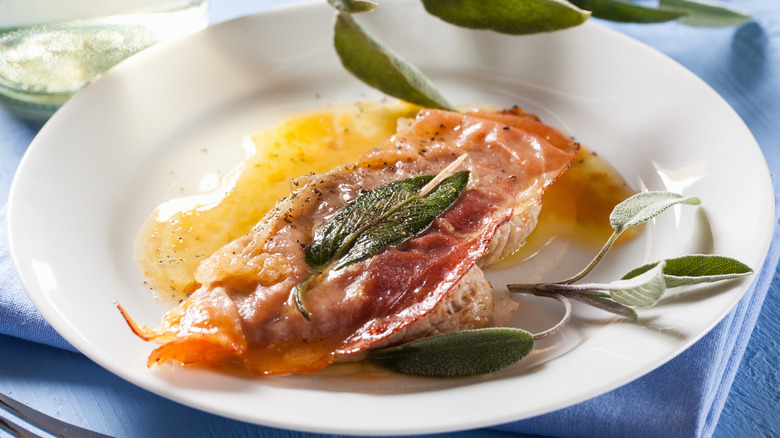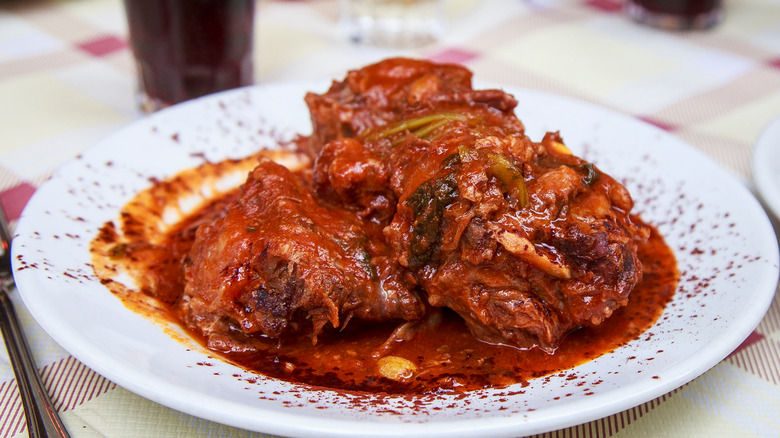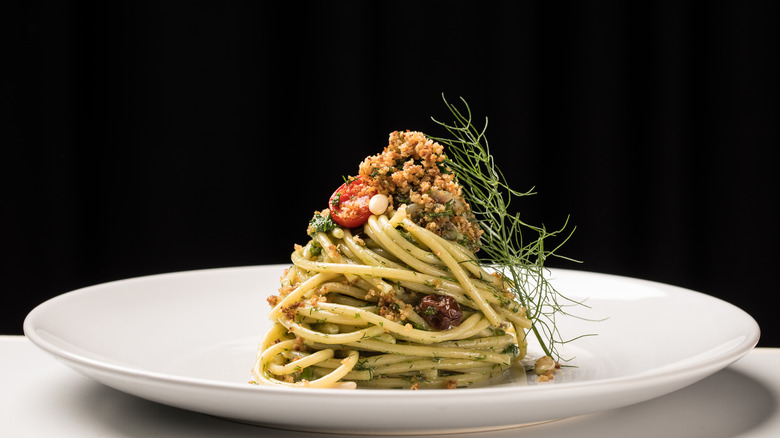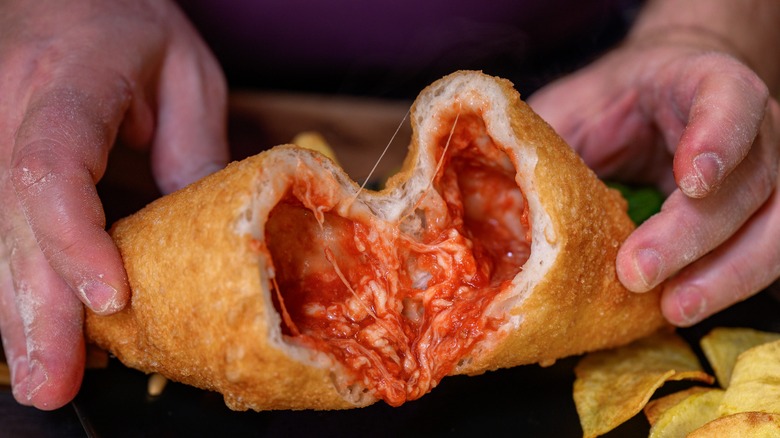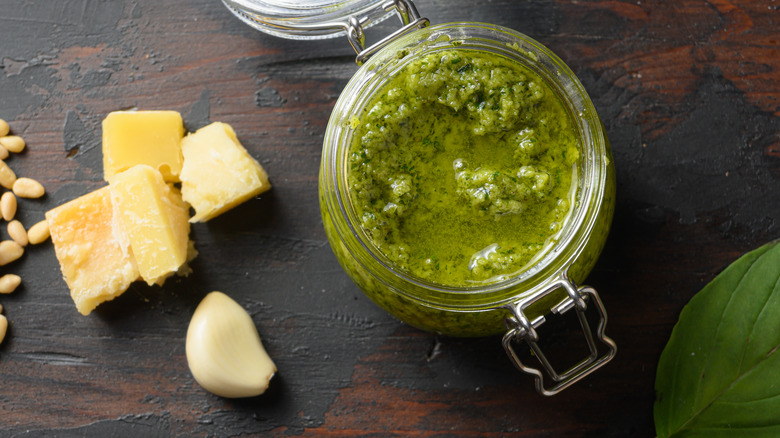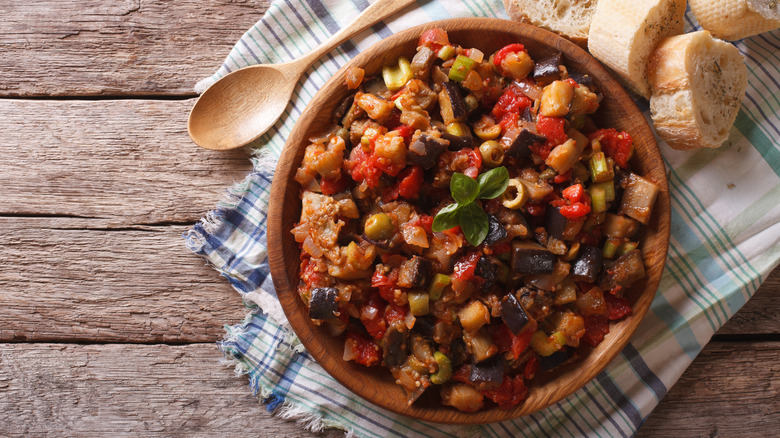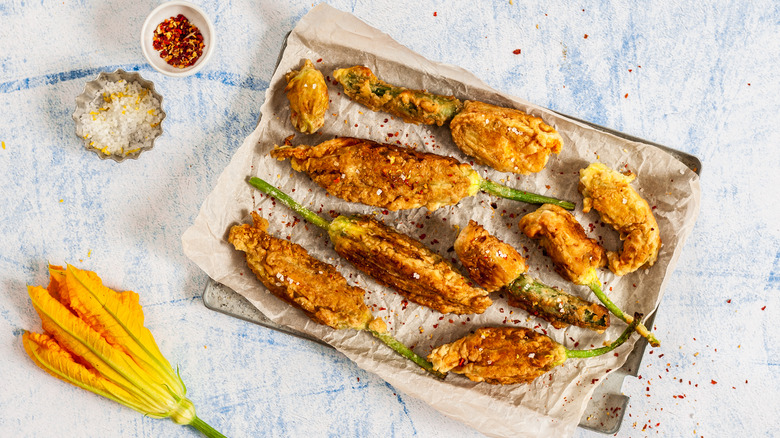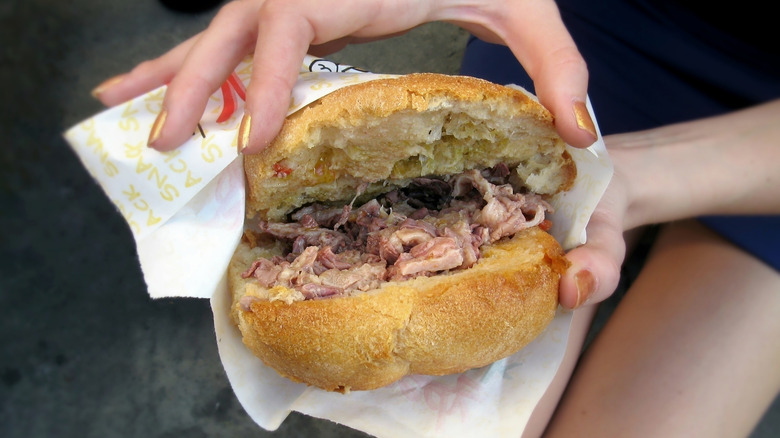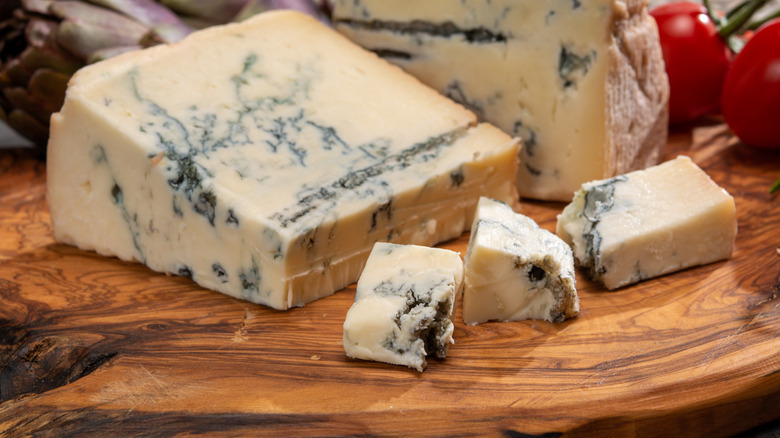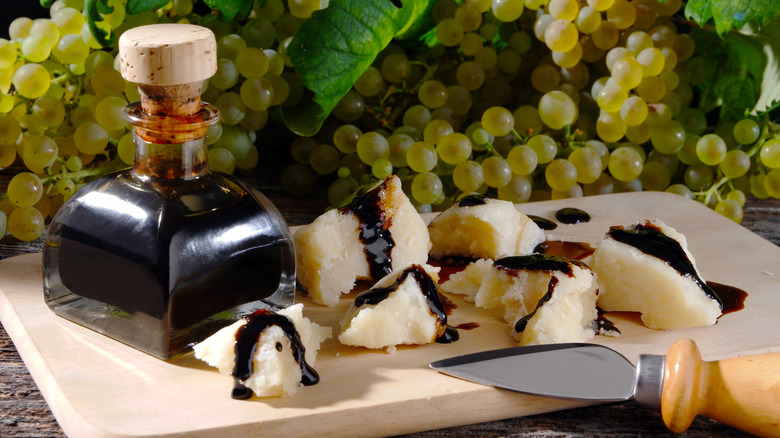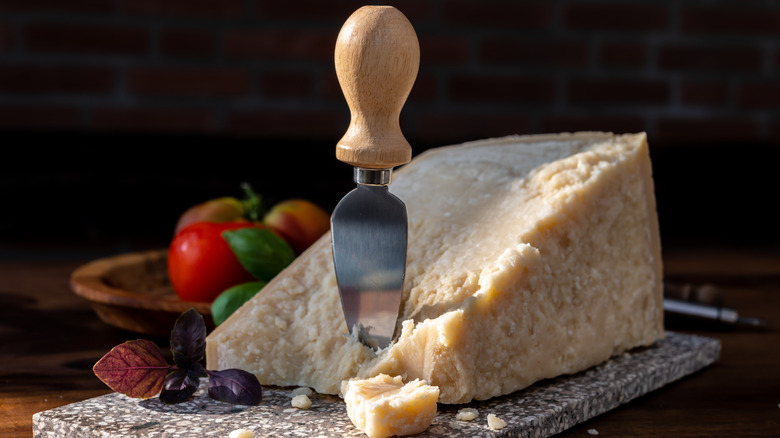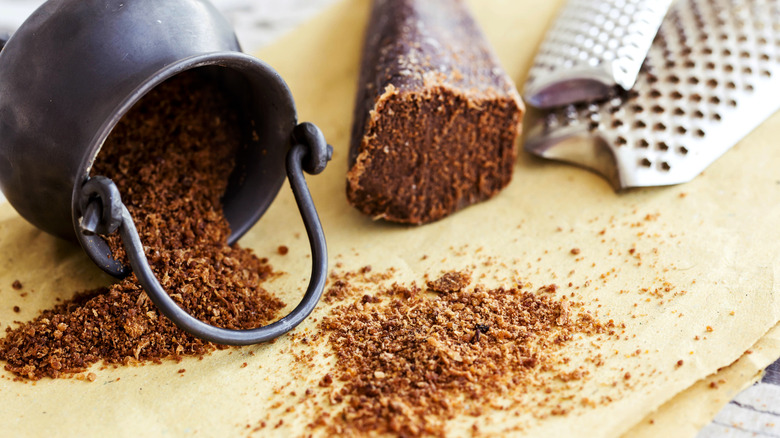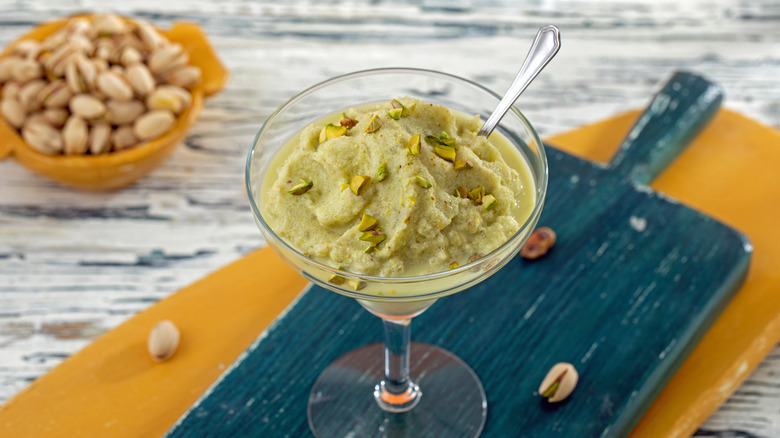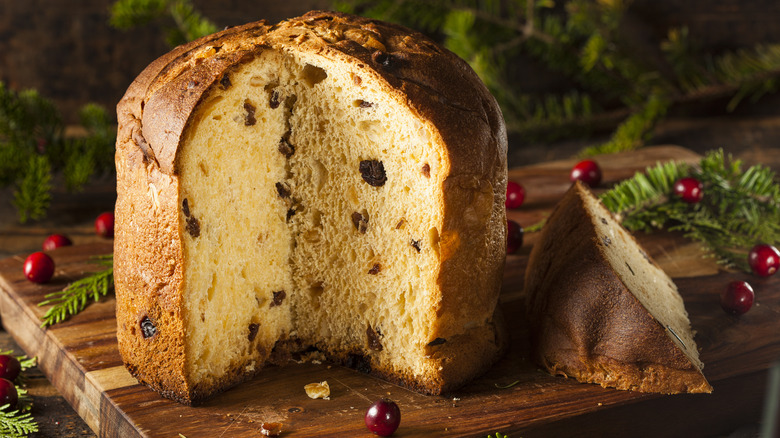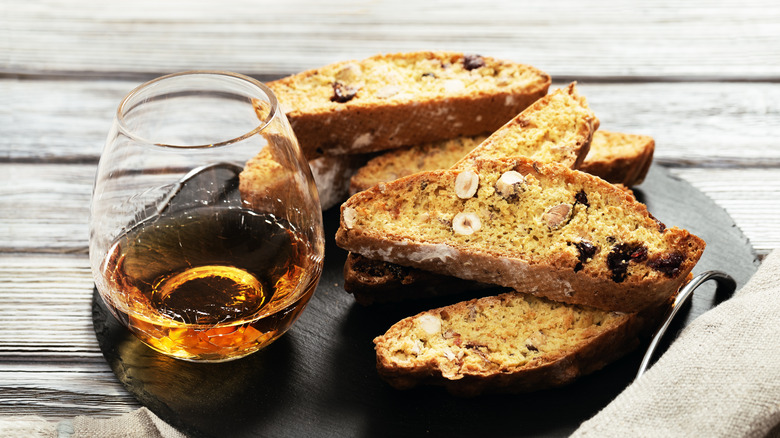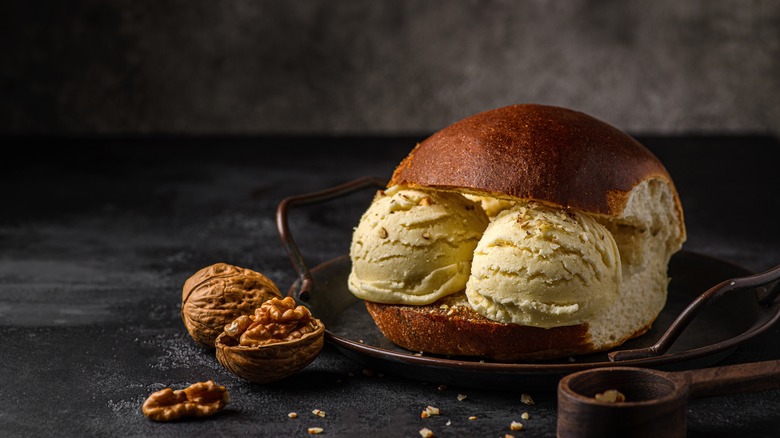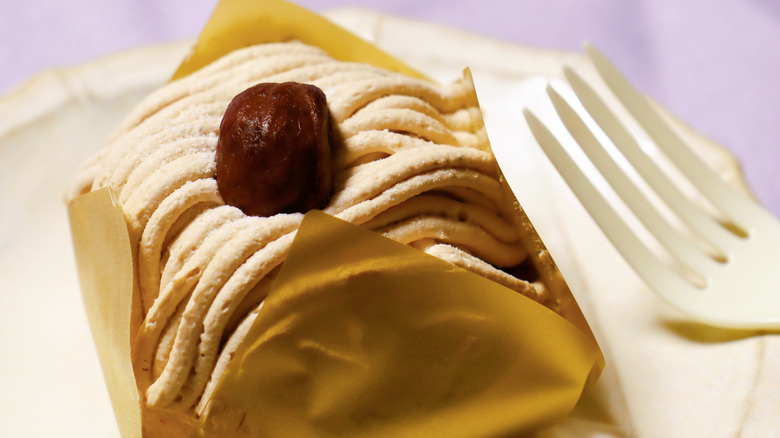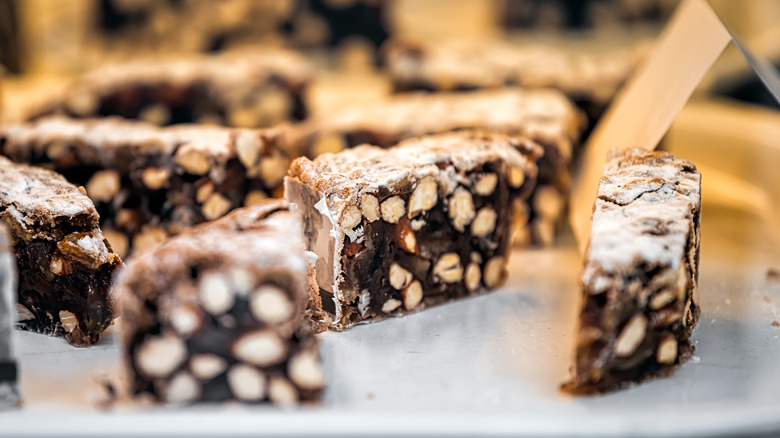39 Unique Italian Foods You Need To Try Before You Die
In 2019, Italian cuisine was voted the most popular cuisine in the world — and no one was surprised. It seems that simple dishes and superb ingredients are a winning combination that most people easily fall in love with. The country has given the world pasta, pizza, and gelato, so you'd think there isn't much more left, but you're in for a surprise. Italy is a culinary giant with regional diversity and culinary lore that remain unparalleled.
With a cuisine as rich as Italian, it wasn't easy to decide what deserved to be in the top echelon. This list features authentic Italian dishes, the country's best ingredients, and the most popular desserts that you should try at least once — though we doubt you'll stop at that. Once you try these, look deeper, try more regional pasta sauces, and investigate the abundance of cheese varieties and scrumptious desserts that will keep you craving more. This list is the best place to start your Italian culinary adventure and to get an overview of some Italian classics that tell a story of how one cuisine conquered them all.
1. Carpaccio
Carpaccio is an Italian dish made with thin slices of raw meat served with various toppings and condiments. It was originally made with beef, but the name is now applied to dishes made with thin slices of a variety of raw meats or raw seafood. The seasonings served on top can vary but should never overpower the main ingredients. Traditional choices include lemon or olive oil, but mustard and mayonnaise also make great complements. The final touch is added with delicate greens and a few slivers of Parmigiano Reggiano. Carpaccio is one of those traditional Italian dishes that showcase the beauty of an ingredient and dress it simply, only to emphasize the quality of the main star of the dish (via La Cucina Italiana).
2. Ragù alla Bolognese
There are many ragù interpretations that pop across Italy, but none is as famous or revered as the one coming from Bologna. Traditionally served with tagliatelle pasta, this comforting meat ragu combines ground beef and pork slowly cooked with onion, celery, carrots, and wine, all doused in tomato sauce (via Eat & Walk Italy).
The internet abounds with discussions about the original recipe, though most take the recipe from Academia Italiana della Cucina as the authentic version — and yes, it does include milk. What we believe to be true is that every family and every Italian nonna has their favorite ragù and a recipe that has been in the family since anyone can remember.
3. Carbonara
Carbonara is the queen of Italian pastas. Although it combines just a few straightforward ingredients — pasta, eggs, guanciale (pork jowl), and Pecorino Romano — the result is a spectacularly creamy pasta dish. An essential final touch to carbonara is a dusting of freshly ground pepper that nicely balances the creaminess (via La Cucina Italiana).
Please note classic carbonara is not made with butter, cream, or garlic, so if you'd like to make it at home, please keep clear of these blasphemous additions.
4. Risotto alla Milanese
Risotto Milanese is one of the legendary regional Italian risottos. This hearty, vibrantly colored dish originated in the north and is particularly associated with Milan — hence the name. Like most Italian classics, it is a simple combination made with few ingredients that are blended in a perfect balance. Arborio rice is slowly cooked in beef broth and is then laced with saffron. Risotto Milanese can be served on its own, but it is usually paired with osso buco (via MasterClass). Remember, for most Italian risottos, the rice needs to be cooked al dente, meaning that it has to have some bite to it.
5. Osso buco alla Milanese
Osso buco is Milan's version of braised veal shanks. The dish gets its character from slow braising in a delectable mixture of celery, carrot, and tomatoes until the meat is so tender that it falls off the bone. Traditionally, the shanks are garnished with gremolata — an aromatic mix of parsley, lemon, and garlic. However, that's not even the best part. After cooking, the marrow inside the bone will become a creamy, spreadable mix packed with flavorful braising juices. For the ultimate Italian experience, osso buco should be paired with risotto Milanese (via MasterClass).
6. Pizza Napoletana
You've probably eaten pizza, but you haven't had authentic pizza if you never tasted the original — the legendary Napoletana. This Napolitano legend is one of the most demanding styles to master. To make the authentic version, all ingredients have to be carefully selected, and each step in the process needs to be dutifully followed. Napoletana has a governing body — the Associazione Verace Pizza Napoletana — that manages pizzaiolo training and specifies the rules when it comes to Neapolitan pie.
The easiest way to try this legendary pizza is to head to Association's website and look for the locations that have been officially approved and certified.
7. Focaccia
Focaccia is simply explained as an Italian bread variety, but it stands for much more than what is covered by that simplified explanation. It is made in several regional versions, varying from the thick and bubbly Genoan variety, which is its most famous representative, to the thin, filled, or even sweet varieties. Savory focaccia is usually topped with olives, tomatoes, or rosemary, but it can withstand virtually any garnish. Despite these differences, most focaccia styles will be doused in olive oil, and as the bread bakes, the edges become delectably crispy and thoroughly infused with olive oil. Serve it on its own or make it into the best sandwich you ever had (via Salt & Wind).
8. Spaghetti alle vongole
Vongole is the Italian word for clams, the main star of this simple seafood pasta. Italy Magazine explains that it can be made with a tomato-based red sauce, but it is usually prepared as a white version that includes garlic, olive oil, chili pepper, and dry white wine. Clams are simmered in the sauce, and the entire thing is then tossed with spaghetti. Instead of spaghetti, linguine or vermicelli make decent replacements. The dish is famous in most coastal Italian regions, and it is a perfect accompaniment to warm summer evenings. It would work best with a glass of chilled white wine on the side.
9. Spaghetti alla puttanesca
Puttanesca might be a new name on the list of your favorite Italian sauces. This tomato-based pasta sauce screams Mediterranean flavors as it also includes Gaeta olives, capers, and anchovies. Garlic and chili pepper are added to the mix, along with some parsley or oregano. It probably originated in Naples but is also popular in Lazio, where anchovies were included, unlike in the original Neapolitan recipe (via 196 Flavors).
Pasta puttanesca is also famous for its name. According to Italy Magazine, the name comes from the word puttana (whore). Though there are many legends explaining the origin of such a storied name, none of them has been supported by enough evidence.
10. Amatriciana
Classified as one of the essential Roman pasta dishes, Amatriciana follows standard Italian ideology: Use a handful of the best ingredients to create a spectacularly simple and incredibly flavorful dish. Cooking School Italy explains that the word refers to the sauce made with three base ingredients: guanciale (pork jowl), pecorino, and tomatoes. The sauce has peasant origins, and it was named after Amatrice, a town in Rieti province.
This pasta sauce is a must-try, but if you decide to make it at home, please avoid adding garlic as it is deemed controversial and was publicly judged by the entire Amatrice community when the chef Carlo Cracco used it in his recipe (via The Guardian).
11. Bistecca alla Fiorentina
Bistecca alla Fiorentina is a legendary meat dish best described as T-bone made Florentine style. This is a traditional Italian dish, and according to Visit Tuscany, its origin allegedly goes way back to the 16th century. The steak is usually thick and hefty in size and traditionally comes from the local Chianina breed.
The preparation is simple — the steak is quickly grilled — and while the outside should be brown, the steak needs to be served rare. Florentine steak is seasoned with salt and is best served with a drizzle of olive oil. For carnivores, this is an essential Italian dish.
12. Fritto misto
Fritto misto is a delicious Italian combination of various fried ingredients. Translated as "fried mix," it can be made with meat, veggies, seafood, or even cheese. The most famous interpretation is a seafood mix where you will get a cone filled with deep-fried squid rings, shrimp, and squid tentacles, but regional variations abound. In Marche, olive ascolane is commonly added to the mix, while the Piemonte version often calls for offal, cheese, or semolina (via Fine Dining Lovers).
Fritto misto is not a revolutionary dish, but when you have perfectly deep-fried ingredients, ideally anywhere on the Italian coast, you've got yourself an ideal food experience.
13. Porchetta
Porchetta is an outstanding pork dish primarily associated with Rome and central Italy. It is prepared with boneless pork filled with flavorful stuffing before it is rolled, spitted, and finally grilled over an open fire. The roll is then sliced, and it's preferably served warm.
According to Eating Europe, in Rome, porchetta is often considered a street food delicacy, but it is also a festive dish made in different Italian regions for important events and celebrations. Either way, this pork delicacy is a must-try as it perfectly marries traditional techniques and classic flavors into an iconic Italian dish.
14. Supplì and arancini
Supplì and arancini are similar deep-fried rice balls that shouldn't be considered the same. Supplì come from Rome and are typically oval-shaped balls made with rice and meat sauce wrapped around mozzarella — resulting in a deliciously crispy treat with a gooey and stringy center. On the other hand, Sicilian arancini can come in different shapes and hold various fillings such as meat ragù or ham and cheese.
Italy Magazine explains that these rice balls are often associated with Arab rule, but as the recipes first appeared in the 19th century, the assumption is not fully supported by evidence. Whatever the origin, these rice balls make a perfect appetizer and delicious street food.
15. Vitello tonnato
Vitello tonnato is a traditional but slightly unusual Italian dish as it combines fish and meat, two ingredients that don't commonly appear together. This scrumptious combination proves that seafood and meat can work together to make a creative, perfectly balanced dish that needs to be tried at least once in your life. Vitello tonnato is made with thin slices of tender cooked veal topped with a creamy fish-based sauce that typically incorporates tuna, capers, anchovies, and lemon juice. The dish is served cold and makes for an ideal main course regardless of the season (via La Cucina Italiana).
16. Saltimbocca alla Romana
The following dish is one of the glorious representatives of traditional Roman cuisine. Saltimbocca alla Romana is made with thin cuts of veal seasoned only with salt and pepper. Each piece is topped with sage and a prosciutto slice and then fried in sizzling butter. The dish is served with a simple white wine pan sauce. The combination of tenderly-flavored veal, sage aroma, and the savory-salty note from prosciutto results in a glorious blend of flavors and aromas that deservedly puts saltimbocca on the list of best Italian dishes (via Turismo Roma).
17. Coda alla vaccinara
Braised oxtail is a dish that stems from peasant tradition, but the tender meat coated in a richly flavored, incredibly thick tomato sauce makes for such a glorious dish that it is now lauded as one of the heartiest Roman staples. Splendid Table explains that the dish got its name after slaughtermen (vaccinari), who were often given undesirable cuts as payment. Oxtail long lost its status of a less favorable cut, and the dish is a must-try for anyone who enjoys comforting classics.
18. Pasta con sarde
You may think you've tried and tested all Italian pasta dishes, but this Sicilian pasta is a whole new ballgame that will better help you understand how contrasting flavors can make a perfect match. Supposedly of Arab origin, this pasta combines some exquisite ingredients starting with sardines as the main protein. The salty fish is then complemented with pine nuts, raisins, saffron, and fennel. Dried breadcrumbs are added as the finishing touch.
The combination of salty, sweet, herbal, nutty, and earthy flavors will create a feast for your taste buds. So next time, stay clear of traditional pasta choices and go for this classic to get a sense of authentic Italian cuisine. It is a standard everyday dish, but it also appears at some important feasts and events (via Sicilian Cooking).
19. Pizza fritta
According to the BBC, pizza fritta is an unconventional and less famous cousin to the legendary Napoletana. This deep-fried version originated as a more affordable variation on pizza Napoletana that didn't call for the use of an oven. It is made with pizza dough, typically wrapped around a cheesy tomato filling. The firmly sealed pocket of cheese is then fried until golden. You can find pizza fritta stalls across Naples, and you'll have it served burning hot while the cheese is warm and gooey. This crispy dish will provide a pleasure that you didn't know you needed in your life. After all, it might be true that all things are better fried.
20. Pesto Genovese
Italy has many pesto variations, but the one from Genoa is its most popular representative and, arguably, the most flavorful of the bunch. As explained by Insider, pesto Genovese calls for a handful of ingredients, seven to be precise, and it has to be made the traditional way for the ultimate pesto result. Basil is the star, but additional components — including Ligurian extra virgin olive oil, salt, Parmigiano, pecorino, pine nuts, and garlic — are essential for a perfect blend that will immediately transport you to Italy.
21. Caponata
Caponata is a dish that stems from Sicilian tradition. According to Delicious Italy, this vegetarian staple first appeared in print in the mid-18th century and was initially referred to as a "dish made up of various things." Today we mostly see it prepared with fried eggplants coated in agrodolce sauce that combines sweet and sour flavors. Olives and capers provide that additional salty kick that makes caponata stand out from any veggie dish you've ever had. Although perfect in its basic form, caponata is an excellent playground for experimentation as well.
22. Stuffed zucchini flowers
Stuffing zucchini flowers and then dipping them in batter and frying until they attain a crisp, golden coating is not one of the ancient Italian culinary traditions, but it is now rooted in the local culinary folklore, especially Roman cuisine. The markets abound with these delicate flowers, typically filled with a combination of cheese (mozzarella) and anchovies. The batter is light and crisp, serving as the perfect contrast to the creamy filling. These brightly-colored flowers are an ideal way to start a meal in Italy. An extra tip: Use your fingers to eat them (via Delicious Italy).
23. Lampredotto
This might not sound appetizing but trusts us on this one. Lampredotto is the most unique and the most flavorful sandwich you'll ever have in your life. It is a Florentine legend — a sandwich made with cooked tripe generously seasoned with olive oil and a combination of garlic and parsley, all tucked inside a crispy roll (via Atlas Obscura).
This sandwich stems from working-class tradition, as offal was usually the most affordable piece of the cow. But this humble dish grew into a legend and is now offered by local kiosks dispersed throughout the city. The tripe is always steaming hot, and the bread is dipped in the cooking juices, creating a medley of flavors you won't stop talking about.
24. Gorgonzola
Gorgonzola is a blue-veined Italian cheese that can only be made in Piedmont and Lombardy. It is usually made with cow's milk, and it comes either as the longer-aged spicy (piccante) version or as a sweet (dolce) gorgonzola that is aged briefly and holds more sweetness. Gorgonzola is savory and pungent, but it perfectly pairs with fresh and dry fruit, nuts, and honey. Alternatively, use it in risottos, pasta, salads, and sauces, or snack on it to thoroughly enjoyed the richness of flavors.
Please note that the original cheese has to have the DOP stamp that certifies it as authentic gorgonzola (via MasterClass).
25. Aceto Balsamico Tradizionale di Modena
If you hastily assumed that this is the regular balsamico hiding in your cupboard, you couldn't be further from the truth. Aceto Balsamico Tradizionale di Modena is that small, expensive bottle you only saw at specialty stores and decided was too much to splurge on. But maybe you should reconsider your reticence.
According to Wine and Travel Italy, the authentic balsamic vinegar from Modena is made following ancient techniques and is oak-aged to create a thick, almost syrup-like vinegar. With a dark, almost black color, Modena vinegar is aromatic and subtly tart, with a perfect balance of sweet and sour notes. It is best used as a garnish; drizzle some over risotto, pasta, or a steak. It even makes a great pairing with desserts and, of course, cheese — serving it with Parmigiano is one of the great life experiences.
26. Parmigiano Reggiano
Parmigiano Reggiano is not your regular parmesan cheese, as the authentic version has to be made with specific ingredients and can only be produced in designated Italian regions. Parmigiano Reggiano is one of the legendary cheese varieties, praised for its texture, flavor, and aroma. This is the cheese that you want to savor and nibble on its own, and a cheese that will add that umami kick to any dish you serve it with. Following the advice of the official Parmigiano Reggiano consortium, never taste this cheese directly from the fridge, and be prepared for the glorious medley of sweetness, saltiness, subtle bitterness, and some hints of herbal notes. An additional tip when buying is that the cheese's final flavor profile and texture will depend on its age.
27. Bottarga
Bottarga is one of those ingredients you never knew you needed, but once you try it, you will be hooked. Affectionately called the truffle of the sea, bottarga is the word that denotes salted and cured fish roe. It is mostly associated with Sardinia and Sicily, and it can be made with various types of roe — tuna, mullet, or swordfish are the most common.
Bottarga is not a dish; it is usually used as a garnish that can dress up and elevate any meal. It is typically grated or finely sliced, adding complexity and a decadent umami component (via Great Italian Chefs).
28. Cannoli
No one should go through life without tasting cannoli — the elongated pastry shells fried till they achieve that crispy perfection and then filled with sweetened ricotta cream. This legendary Italian dessert even sounds great on paper.
Cannoli are originally Sicilian, but they have long outgrown their native region. Though the best expressions are found in Sicily, cannoli have been internationalized, so there is absolutely nothing stopping you from going and living your best life with cannoli in hand. As cultural heritage expert Maria Oliveri shared with BBC, the best cannoli is always made fresh so that the pastry can retain crispiness, so try to find the store that makes them this way. If all else fails, you should at least once go to Sicily, and you might as well go for the cannoli (we're not here to judge).
29. Granita
Eating granita on a scorching summer day in Sicily is a necessity. According to Italy Magazine, Sicilian granita is an icy treat made from sugar, ice, and fruit that falls somewhere between gelato and sorbet. The dessert was introduced by Arabs, but it became firmly ingrained into the Sicilian food culture. Granita is usually enjoyed as breakfast or a light snack between meals. It is traditionally served with brioche that should be torn and dipped in the granita. Some of the best granita flavors feature lemons, almonds, mulberry, pistachio, and coffee.
30. Tiramisu
When you think of Italian desserts, tiramisu is probably the first thing that comes to mind. There is no other dessert so closely associated with Italy than the layered combination of coffee-dipped ladyfingers coated in a creamy mixture of mascarpone and eggs and then topped with a thin layer of bitter cocoa to balance out the sweetness.
Whoever created tiramisu — the origin was long disputed and partially settled in 2017 when Friuli was awarded this honor — gave it an appropriate name. According to the Academia del Tiramisu, the name stems from the local dialect (tireme su), which means pick-me-up. We can't think of a better dessert choice for an afternoon or after-dinner boost.
31. Panettone
That store-bought cheap panettone bread you once had for Christmas is not what we are talking about here. The authentic Italian panettone is an artisanal wonder that impresses with its texture and flavor. Original panettone hails from Lombardy, and as it is complex and time-consuming to make, it is best left to the experts to tackle it, and you need to make sure that you buy the original.
Tradition suggests pairing the bread with some sparkling or dessert wine, and we don't argue against tradition, so for the upcoming holidays, stock up on the authentic panettone and some wine and make it a delectable Christmas custom for the future.
32. Cantucci Toscani
Cantucci Toscani are not much to look at. They have a somewhat rustic appearance, but their texture and flavor certainly compensate for the rough presentation. These hard cookies that are generously flavored and packed with nuts or dry fruit are a Tuscan tradition, though similar versions are found in almost all corners of the country (via The Florentine).
Cantucci are double-baked and thus have a firm, hard-to-break texture. Ideally, for the authentic Italian experience, you are supposed to dunk them in wine. And no, milk just won't do. Dip these cookies in sweet vin santo and be amazed at how Italians have a natural gift for pairing food and wine to achieve ultimate bliss.
33. Brioche con gelato
Gelato is almost synonymous with Italy, and it has become so popular you don't have to travel to Italy to get a taste of milky, creamy ice cream and the myriad creative gelato flavors, but trying gelato with brioche — a soft, subtly sweet bun — is where things get more interesting.
According to SBS, pairing gelato and a sweet bun is a Sicilian thing, and surprisingly, it is enjoyed for breakfast. Knowing how scorching summers can be on the sunny Italian island, it's no wonder that the balance of the buttery bun with the creamy, cold gelato sounds like a match made in heaven.
34. Sfogliatella
If you've ever eaten a lobster tail pastry, you might have an idea of what makes sfogliatella so special, as it is the original version. As Atlas Obscura clarifies, according to the most famous legend, this pastry was allegedly created by the nuns at the Santa Rosa convent on the Amalfi Coast.
Sfogliatella comes in two versions. The more popular riccia is made with phyllo pastry arranged to resemble a layered cone, while the round-shaped frolla opts for shortcrust pastry. Both versions hide a delectable citrus-infused ricotta filling. These pastries are a breakfast staple and should be paired with freshly brewed espresso for the ultimate breakfast combo and your new favorite Italian experience.
35. Affogato
In a perfect world, you would always end your dinner with a scoop of ice cream doused in freshly brewed espresso. For Italians, this is tradition. The combination goes by the name affogato, and by now, it is well known in international Italian restaurants, so don't ignore it if you ever see it on the menu. The combination of creamy ice cream slowly oozing and mixing with the earthy espresso flavors will transport you directly to culinary heaven. Arguably, there is no better way to finish your meal (via VinePair). The only thing that could make it better is to have it in Italy.
36. Montebianco
Montebianco is an Italian dessert you've most likely never heard of, which we are here to fix. This seemingly simple dessert is a seasonal fixture that plays a starring role during fall and winter. It features the classic autumnal staple: earthy chestnut purée flavored with rum and (sometimes) cocoa. The purée is topped with feather-light whipped cream that counterbalances the strong earthy chestnut note.
When assembled, the desert unmistakably resembles a snow-capped mountain, and it was named after the highest peak in the Alps. The peak is located near the Italian-French border, and the dessert is also shared between the nations, but in France, you will have more luck finding it under the name Mont Blanc (via La Cucina Italiana).
37. Torta Caprese
Caprese was made for chocolate lovers. This flourless Italian cake hails from Capri — hence the name — and it puts chocolate at the center stage. As SBS explained, according to the traditional lore, this delicious treat was made by accident when a chef forgot to add flour to a cake recipe.
Rest assured, there are no mistakes in this cake. As there is no flour inside, the cake has a dense, almost gooey center and gets flavor both from cholate and finely ground almonds. The cake can be assembled in no time, so if you make the mistake of not visiting Capri, don't commit the capital error of not making this accidental Italian creation at home.
38. Panforte
Siena is a small Tuscan city that gave birth to panforte — a traditional Christmas cake packed with spices and speckled with candied fruit and nuts. Panforte is an ancient Italian delicacy usually shaped in a large disk. Traditionally it can be topped with cocoa (or powdered sugar for the Margherita version).
Because of the warming spices, nuts, and chewy texture, panforte is a unique treat, and its bold flavors are ideally savored during the winter season or even better as a sweet Christmas treat served with dessert wine on the side (via Italy Bite).
39. Semifreddo
Not a mousse and not entirely an ice cream, semifreddo is a delicious hybrid that offers the best of both worlds. It is the no-fuss and no-churn dessert option if you're craving some ice-frozen sweet treats.
Cook's Info explains that semifreddo is made with egg custard combined with whipped egg whites or whipped cream that deliver that mousse-like texture. Semifreddo will typically include several layered flavors, and it is frozen in cake molds, meaning you can easily portion it and enjoy its semi-frozen texture. You can additionally enrich it with crumbled cookies, fruit, or nuts.
